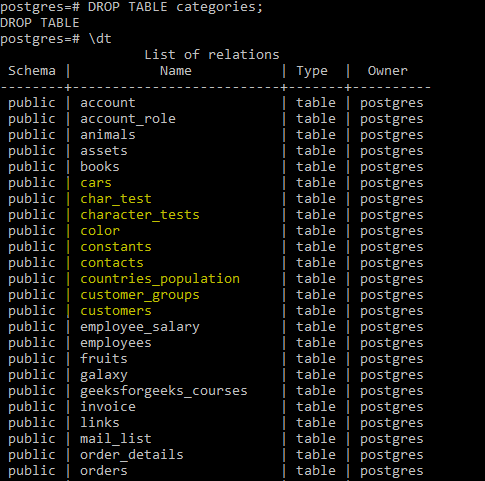
Here, constraint_name can be the name of the UNIQUE constraint (column_name) - A column name where unique constraint is specified It specifies where it will check for the uniqueness of the rows inserted with the existed rows. target can be any column, a UNIQUE constraint, or a WHERE predicate statement.
POSTGRESQL INSERT INTO TABLE ALL COLUMNS UPDATE
When you insert a new row into the table, PostgreSQL will UPDATE the row if it already exists, otherwise, the new row will be inserted.

You can also rename the returned value in RETURNING clause by using the AS keyword followed by the name of the output, here output_name.Įxample: INSERT INTO device_data (first_name, last_name, email, gender, ip_address).if you put an asterix(*) as output_expression, it will return all the columns from the inserted rows as the output.output_expression after the keyword RETURNING is the expression that specifies the columns to be returned as the output.

The syntax is as follows: INSERT INTO table_name (column_list) You can also return the inserted rows information in PostgreSQL by using the RETURNING clause in the INSERT INTO statement. Read PostgreSQL ALTER TABLE + 19 Examples PostgreSQL INSERT Multiple Rows RETURNING

And the COUNT is the number of rows that are inserted successfully by the INSERT statement.The INSERT statement returns 0 as the OID value. PostgreSQL uses the OID as a PRIMARY KEY for the tables in the system. NOTE – The columns and values in the column-list and value_list respectively should be in the same order.The above statement will return a command tag in the form – INSERT OID COUNT.comma-separated multiple value-lists has to be supplied after the keword VALUES.column_list is the list of the columns has to be specified whose values you want to insert into the table within parenthesis.table_name is specified after the keywords INSERT INTO, which is the name of the table to which you want to insert rows.The syntax is as follow: INSERT INTO table_name (column_list) You can insert more than one rows at a time in a single statement in PostgreSQL by specifying comma-separated multiple row values in value list form as VALUES in INSERT INTO statement. PostgreSQL INSERT Multiple Rows from another table.PostgreSQL INSERT Multiple Rows from SELECT query.PostgreSQL INSERT Multiple Rows from array.PostgreSQL INSERT Multiple Rows IF NOT EXISTS.PostgreSQL INSERT Multiple Rows ON CONFLICT.PostgreSQL INSERT Multiple Rows RETURNING.Use LIMIT to specify top 20 rows, but I think you need to sort them using ORDER BY clause first. I don't like that nested dblink, but AFAIK I can't reference to tblB in dblink_exec body. If my understanding is correct (postgres has tbla and dbtest has tblb and you want remote insert with local select, not remote select with local insert as above): psql dbtest I just saw your revised question (closed as duplicate, or just very similar to this). You can make it as prepared statement if you want and it works as well: PREPARE migrate_data (integer) AS

PostgreSQL has record pseudo-type (only for function's argument or result type), which allows you query data from another (unknown) table. INSERT INTO tblB (time) VALUES (5000), (2000) ĬREATE TABLE tblA (id serial, time integer) įROM dblink('dbname=dbtest', 'SELECT id, time FROM tblB') For example: psql dbtestĬREATE TABLE tblB (id serial, time integer) As Henrik wrote you can use dblink to connect remote database and fetch result.


 0 kommentar(er)
0 kommentar(er)
